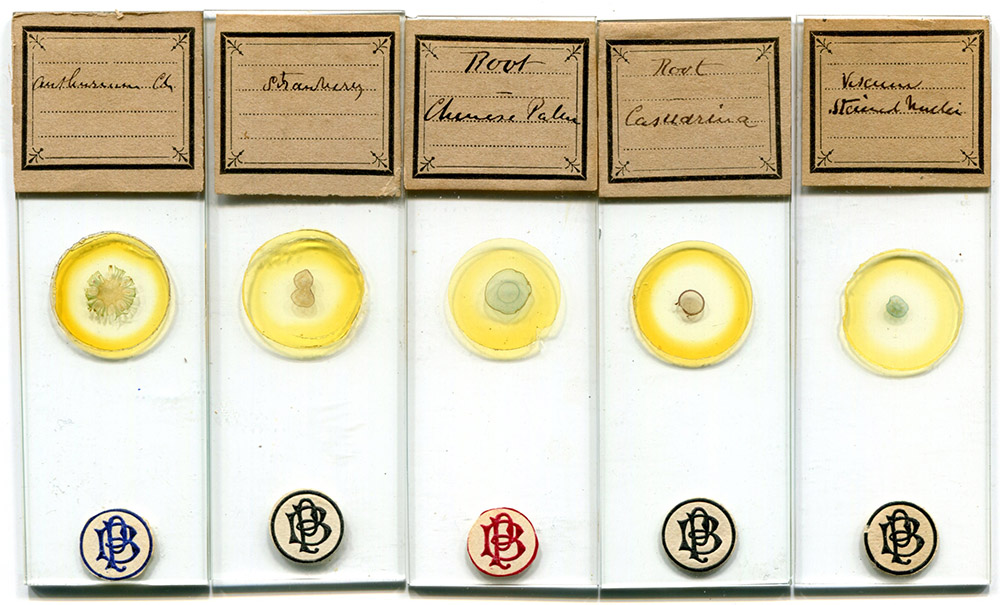
Figure 1. Circa 1883-1889 microscope slides by Bernard Piffard, with circular labels bearing his monogram "B P".
Bernard Piffard, 1833 - 1916
"B. P."
by Brian Stevenson
last updated March, 2021
Microscope slides from England are frequently seen that bear a circular label with the monogram "B P" (the order of the letters is not obvious, and Brian Bracegirdle suggested that it was "P B") (Figure 1). The maker of these slides became apparent with identification of two unusual slides with the "B P" monogram that bear 5 separate specimens (Figure 2). The specimens and their numbering, on both slides, correspond with advertisements from a professional slide-maker named Bernard Piffard.
Piffard was a relatively well-to-do man who involved himself in many projects. His parents were avid entomologists, so he spent a lot of his youth in pursuit of insect specimens. Later, he travelled through Europe, India, and Canada, and accompanied Henry Bates on his excursions in South America. He settled down back in England, married and became a Baptist minister. For many years, he lived and preached in Hemel Hempstead, Hertfordshire, and explored the local lands and its insect and plant inhabitants. During the early 1880s, Piffard began producing microscope slides on a commercial scale. These were primarily of botanical subjects, although he mounted a few insect specimens and produced a series of human pathological slides during 1889. His slide-making venture appears to have ended in 1889. After a considerable lapse, Piffard advertised slides of fungal spores in 1907 (Figure 6). The majority of Bernard Piffard's slides that are encountered today probably date from his ca. 1883 to ca. 1889 period.
Figure 1.
Circa 1883-1889 microscope slides by Bernard Piffard, with circular labels bearing his monogram "B P".
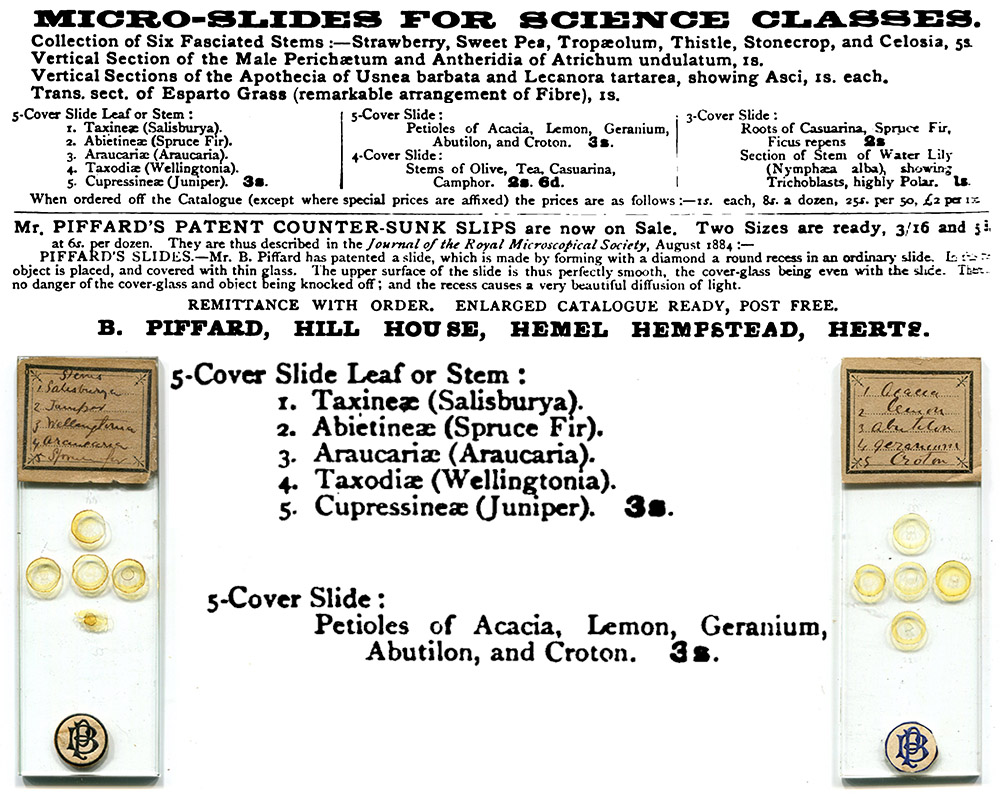
Figure 2.
Conclusive evidence that mounter "B P" was Bernard Piffard: an 1884 advertisement in "Nature" described slides that each contained multiple specimens, which match the illustrated "B P"-monogrammed slides. Piffard etched numbers in the glass slides, adjacent to each specimen, to guide the user.
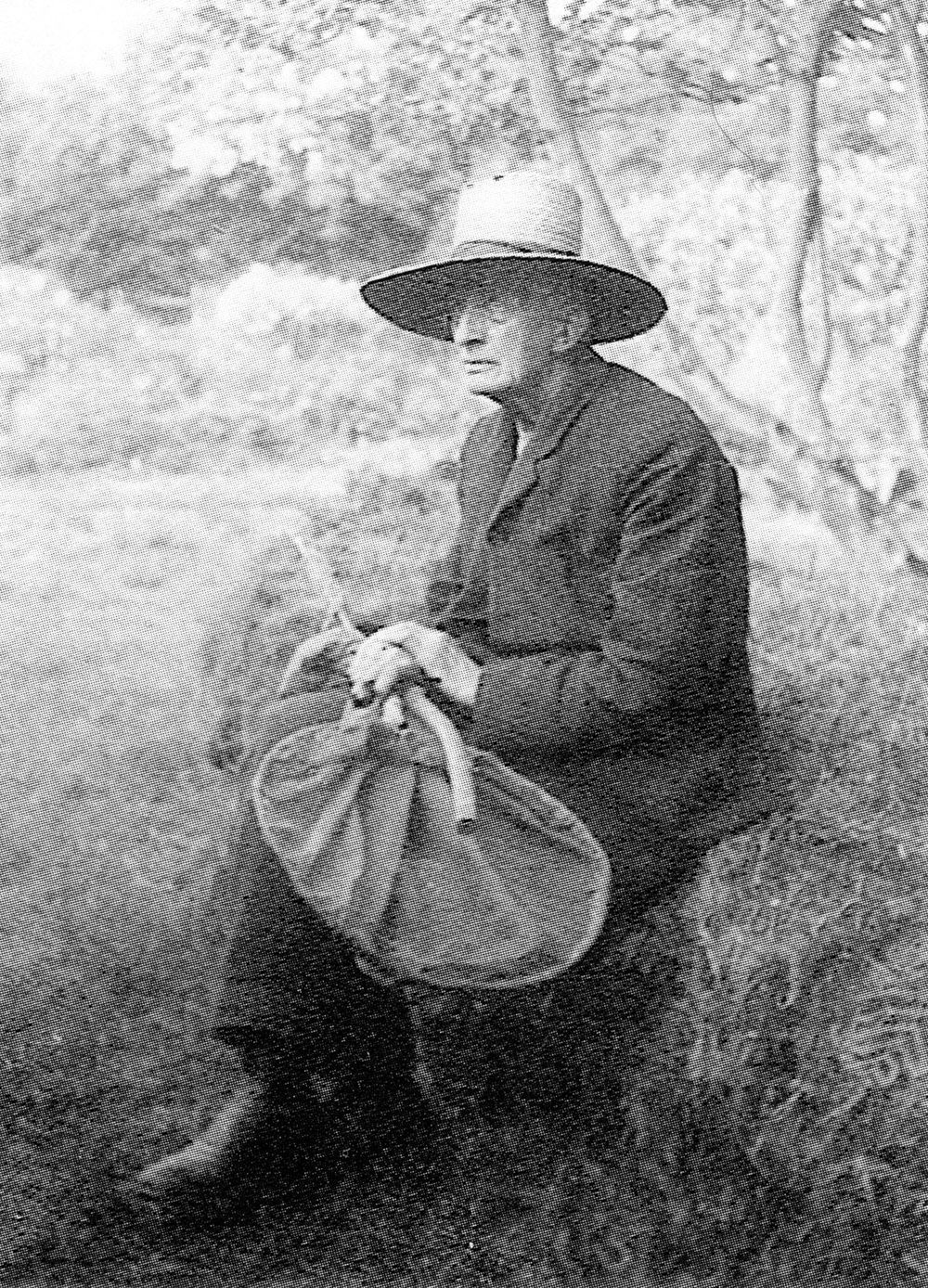
Figure 3.
Barnard Piffard, circa 1905, when he lived in Brockenhurst, New Forest. Adapted for nonprofit, educational purposes from "The Aurelian's Fireside Companion", 2005.
Bernard Piffard was born in Islington (London area) on May 15, 1833. He was the eldest child of James Guerard and Jemima (nee Sabine) Piffard. The family descended from Huguenots who had emigrated from Switzerland.
Father James was a wealthy investor, described as a "stock broker" in the 1841 census. An obituary of Bernard's younger brother, Albert, stated that "He never earned money, for which there was no need". As the eldest brother, Bernard was presumably in a similar state. In this light, his microscope slide-making business was probably an interesting diversion that brought in a little extra money, but was not essential for putting bread on the family table.
Father James was described as having "collected Lepidoptera, and was a good all-round entomologist; his favourite haunts were the woods around Paris". Mother Jemima was reported to have "collected beetles … she used to find Crioceris merdigera, when a girl, on lilies in the garden of the Manor House, Islington, and noticed both its smell and stridulation". The parents passed their love of insects and nature in general on to their children.
James Piffard died in 1852. It was later reported that "his collections passed to Mr. Bernard Piffard".
Bernard was "educated partly in London and partly at Nyon in Switzerland, he was intended for the medical profession, for which he studied at University College, London, and, though he never qualified, his knowledge of medicine proved of great use to him in his travels. Soon after leaving college, impelled by that 'wander lust' which, he admitted, was always with him, he journeyed to the then almost unknown mountains of Armenia, narrowly escaping from the country with his life after having been robbed of all his belongings, including botanical and entomological collections. In 1854 he was up the Demarara river, living for some months in an Indian village, collecting plants and insects and studying the folk-lore of the natives; while in 1855 we find him attached to the Turkish Army in the Crimea as an interpreter, a post which, no doubt, he filled admirably on account of his intimate knowledge of the Turkish language. After the fall of Sebastopol he returned to this country, and at once made arrangements for a trip to the Amazons, being fired by the descriptions contained in the articles then appearing in the 'Zoologist' from the pen of the celebrated naturalist, W.H. Bates. He visited Bates and collected with him for a time, afterwards journeying further up the river, and returning to England in the following year".
Bernard Piffard married Alice Matilda Watt at St. Clement Danes, London, on December 2, 1858. The 1861 censes recorded them as living in St. Pancras, London, with Bernard's occupation listed as "pursue chemistry". In April, 1861, he was awarded a patent for "Improvements in the preparation of non-conducting substances for the deposition thereon of metals by electric action".
Bernard and Alice later moved to "Epping, where he became intimate with Henry Doubleday and Dr. H.G. Knaggs" (renowned horticulturist and entomologist, respectively). By 1868, they had settled in Hemel Hempstead, Hertfordshire, and begun raising three daughters and a son. The family consistently employed cooks and housemaids to keep their home.
The Piffard family were "dissenters" (despite Bernard and Alice being married by the Church of England). Bernard took up the ministry in Hemel Hempstead, preaching at the Apsley Road Chapel. He published at least three religious texts, The Law of Patmos in 1871, The Duration of the Ages in 1895, and The Abode of Departed Saints, and a book of hymns, Evensong, in 1872.
On February 11, 1875, "Mr. Bernard Piffard and Mrs. Piffard" became charter members of the Watford Natural Historical Society.
In 1882, Bernard Piffard published an essay on "Scientific progress in Hertfordshire", describing the scenery, insects, and plants of his home.
That same year, Piffard put forth his name in response to an appeal from Hardwicke's Science-Gossip for people who were "willing to afford local information in the several branches Natural History which they study to fellow-naturalists visiting their district, or desirous of such information". Bernard stated that he was keen on "several branches (of) Botany, Entomology".
Also in 1882, he published the following exchange request in the popular scientific magazine Hardwicke's Science-Gossip, "For exchange, 400 or 500 lepidoptera, including good series of Orion, taminata, extersaria, consortaria, W. album, Common lepidoptera will be accepted. The desiderata being numerous, a visit will be undertaken by advertiser for purpose of exchange, if the greater part be wanted and the distance not very great. A London correspondent preferred". This large collection, evidently located in London, was probably that of Bernard's father - younger brother Albert's obituary stated that James Piffard's "collections passed to Mr. Bernard Piffard, of Brockenhurst … who subsequently gave them away in the New Forest".
Piffard had amassed a considerable number of microscope slides by the early 1880s, many of which appear to have been of his own production. In 1882, he published exchange offers in hopes of acquiring new slides or other items of interest: "For exchange, large stock of microscope slides: vegetable sections, dissections, and many sphagnum leaves, stained and true to name, all mounted in Canada balsam, and good workmanship. Wanted, British wild plants: chief local ones, also northern ones, and British Longicorns. The slides will be sent on approval", and "Slides of lead formate, ammonium chlorate, and nitrosalicylic acid, neatly mounted in Canada balsam. What offers in slides? Vegetable tissues preferred".
Perhaps inspired by responses of interest in those slides, Piffard began his commercial venture during 1883. His initial offerings featured mounts of multiple specimens per slide, which likely drew attention as a cost-effective option for buyers who wanted to compare and contrast related items. The earliest known indication of Piffard's business is a paid advertisement that appeared in the October, 1883, issue of Hardwicke's Science-Gossip (Figure 4). That advertisement spanned the full width of a page, and would have cost a substantial fee. Piffard continued to place similarly large advertisements in Science-Gossip and Nature throughout the decade, implying that the business of slide-making and distribution was worth his time and money.
Experimenting with mounting methods led Piffard to patent a novelty in 1884, "Mr. B. Piffard has obtained a patent specification … and has sent us a slide made in accordance with it as a sample. A round recess is made in the glass slip of the necessary depth. In this the object to be mounted is placed, and covered with the usual thin disk of microscopic glass. In this way the upper surface is perfectly smooth, as the surface of the disk is even with that of the slip. No danger occurs, therefore, of the cover-glass and object being knocked off; and the hollowing of the recess, which is done by means of a diamond, causes a very beautiful diffusion of light, such as we have not noticed in ordinary mounts. For beauty of finish and neatness, there can be no doubt that Mr. Piffard's plan is superior to any yet brought out". (Figure 4).
In 1886, he developed a method for staining microscopical fungi with iodine. He wrote, "Many of the micro-fungi when mounted permanently in Canada balsam become so transparent as to be nearly invisible. If previously exposed to the action of iodine vapour, they assume, when mounted, a clear yellowish-brown colour by which their structure is beautifully defined". He sent examples to the editors of Hardwicke's Science-Gossip, who wrote, "From Mr. B. Piffard we have received several slides of botanical specimens, some of them stained by his new process of iodine vapour. Among them are vertical sections of leaf of carnation, showing stomata; the dodder (Cuscuta) with its tissues imbedded in the host-plant; Hyphae of fungi, etc.".
In addition to making a bit of money from his slides, Piffard used them as trading material to acquire items for his other hobbies. His reputation as a slide-maker probably helped him to arrange good exchanges. He evidently collected old coins, and in 1885 posted the following in Hardwicke's Science-Gossip: "Wanted, pennies, halfpennies, and farthings of Edward I, Edward II, and Edward III. Flint flakes in exchange. Micro slides for exchange", and "Wanted, in good preservation, Edward III, half noble; Richard II, quarter noble; Henry V, noble; Henry VI, noble and half noble; Edward IV, noble and half noble, and half angel; Henry VII, angel; Henry VIII, angel and quarter angel, in exchange for micro slides (histological and morphological)". In 1889, he requested, "British stone implements in exchange for slides", "good specimens of most of the British Grasses, in exchange for Botanical, or Pathological micro-slides (the diagnosis of the Pathological guaranteed)", and "autograph letters of celebrated naturalists, in exchange for good botanical micro slides".
It is particularly notable from the above-described exchange offers that Piffard had "histological and morphological" mounts available as early as 1885. Presumably, these were human or animal specimens, suggesting that he had developed connections with a surgeon, etc. to provide such material. Those specimens may have been fairly limited, since were offered as exchanges, but not in any identified sale advertisements from before 1889. A source of substantial amounts of diverse pathological specimens was evidently arranged by the start of 1889, as he then began to publish advertisements for the sale of numerous "pathological micro-slides" (Figure 5).
Piffard appears to have ceased commercial production of microscope slides in 1889, as no later advertisements have been identified.
During the late 1880s, Piffard developed another venture by inventing and marketing a synthetic fertilizer known as "Silicate Manure". An 1882 report in the Journal of the Royal Agricultural Society of England stated, "We have analysed a sample of the Silicate Manure invented by Mr. Bernard Piffard, of Hill House, Hemel Hempstead. We find, as the result, that this manure contains a very large proportion of silicic acid, much of which is, no doubt, in a form capable of ready assimilation by vegetation. The absolute necessity of a supply of silicic acid to cereals in particular is well known. In this invention we have an ingenious endeavour to adapt natural methods of conveying silicic acid in a suitable form to plants. We are of opinion that this invention is based upon sound principles, and it is very probable that the idea which guided Mr. Piffard in the preparation of his Silicate Manure has led him to conclusions which will prove of considerable importance to agriculturists generally". The 1891 census listed Bernard Piffard's occupation as "Baptist Minister, Silicate Manufacturer".
Piffard made occasional long-distance collecting trips. According to a published memoriam, "During 1886 or 1887 he lived at Gap (France), where he made a collection of Alpine insects, and soon afterwards spent a season in the backwoods of Nova Scotia. His last trip abroad was in 1896, when he voyaged to the Rio Negro (South America). Some two or three months after reaching the interior, however, he was attacked by fever, and lack of attention and strain caused by being obliged to watch continually his two mutinous followers, who attempted to murder him, brought on an illness from which he did not recover for many months".
Bernard's wife, Alice, died in 1891. He took his ill-fated trip to South America a few years later (see above).
In 1901, he moved to Brockenhurst, Hampshire, in the New Forest area. Soon afterward, he published a description of the vicinity and its natural life as "Lymington and its insects". During 1902, he published advertisements to sell insects that he collected int eh New Forest (Figure 6). In 1905, he advertised his services as guide: "New Forest - Information re localities, local insects, gratis; excursions conducted.-B. Piffard, Naturalist, Brockenhurst". A memoriam stated that he was, "well known to the many collectors who visit that (to use his own expression) 'Mecca of the Entomologist'. Always willing to lend a helping hand to the novice or show a good locality to any 'brother of the net', the almost boyish enthusiasm with which he arranged an excursion or greeted the capture of a rare specimen was most refreshing. During the following years he amassed a considerable collection of the local coleoptera, diptera, and hemiptera, but unfortunately did not preserve data, except of a somewhat fragmentary description. He founded at Brockenhurst the 'New Forest Natural History Society', which still flourishes, and of which his daughter, Miss C. Piffard, is now Honorary Secretary".
Piffard began a new slide-making venture in 1907, offering mounted "spores of fungi". The advertisement shown in Figure 7 was published in Nature, which would have been a fairly considerable expense. I only found one such advertisement, however, suggesting that this was relatively short-lived.
The 1911 census listed 77 year-old Bernard as living on "private means". Two years later, he married 29 year-old Edith Ward, who had a 3 year-old child who had been born out of wedlock.
Bernard Piffard died on March 28, 1816. His memoriam concluded with, "Bernard Piffard contributed little or nothing to scientific literature, which seems strange, his knowledge being great and his pen ready, as is witnessed by the many scholarly articles written by him for the local papers. In politics an advanced Radical (he was at one time editor of a paper called the 'West Herts Radical'), by religion a Baptist, though of very unorthodox views, a fluent preacher, writer of hymns, student of chemistry, archaeology, Greek, and many other subjects, inventor of a method of electro-plating, also of a liquid smoke for curing hams, etc., author of a book of poems (some of which, though not the best, deal with entomology, viz. 'Sugaring', 'The Fly Catcher', 'Lament of a Dipteron', etc.), also of a book, entitled 'The Abode of Departed Saints' - his was indeed a versatile mind. As a raconteur he was at his best, dry and often rather caustic humour, coupled with an easy flow of language and wealth of gesture, rendering it a delight to listen to his stories of adventurous collecting in many lands".
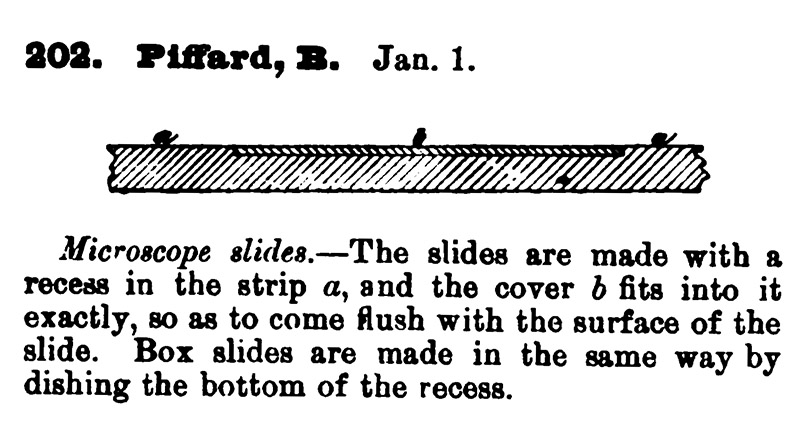
Figure 4.
Diagram from Bernard Piffard's 1884 patent for microscope slides which have a recess to fit a cover slip.
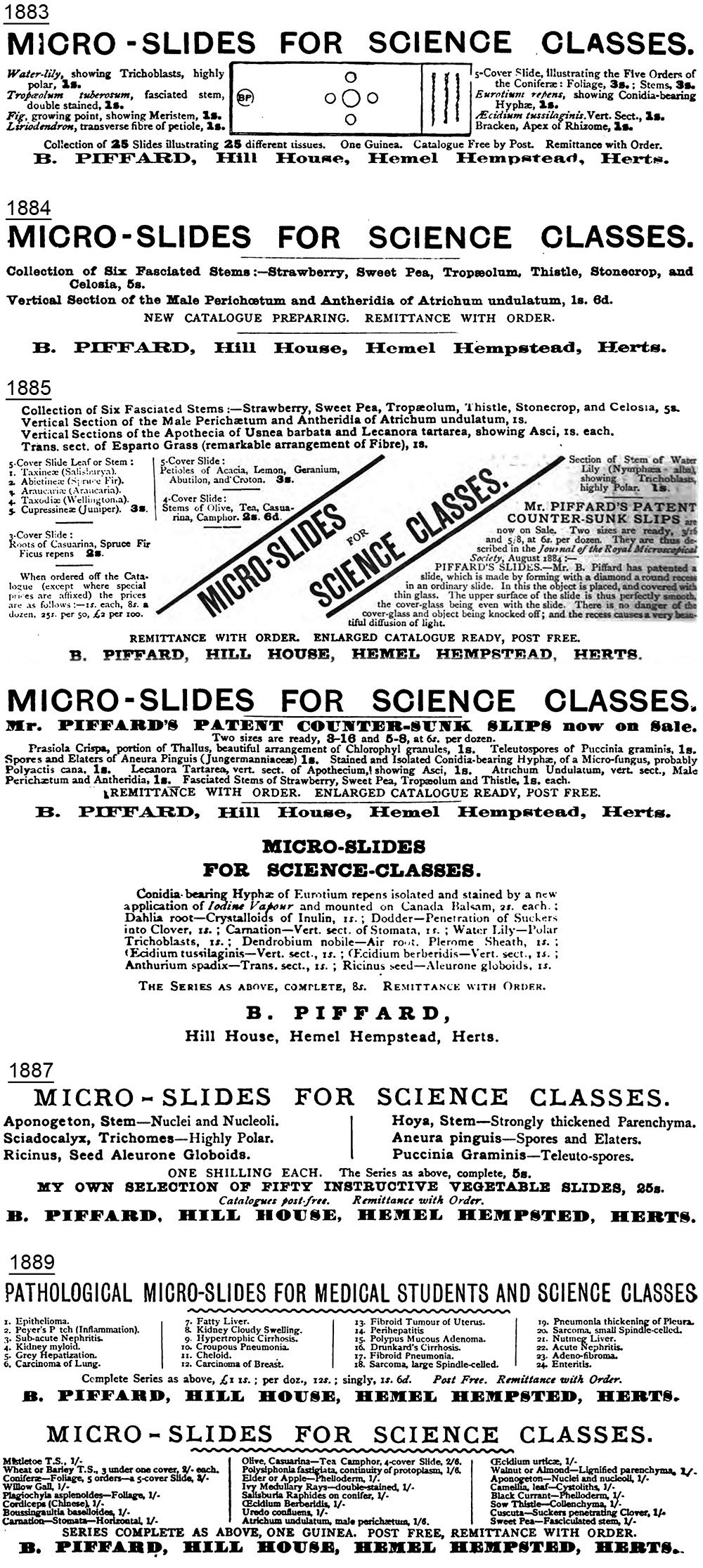
Figure 5.
Advertisements from Piffard that appeared in "Hardwicke's Science-Gossip" and "Nature" between 1883 and 1889.
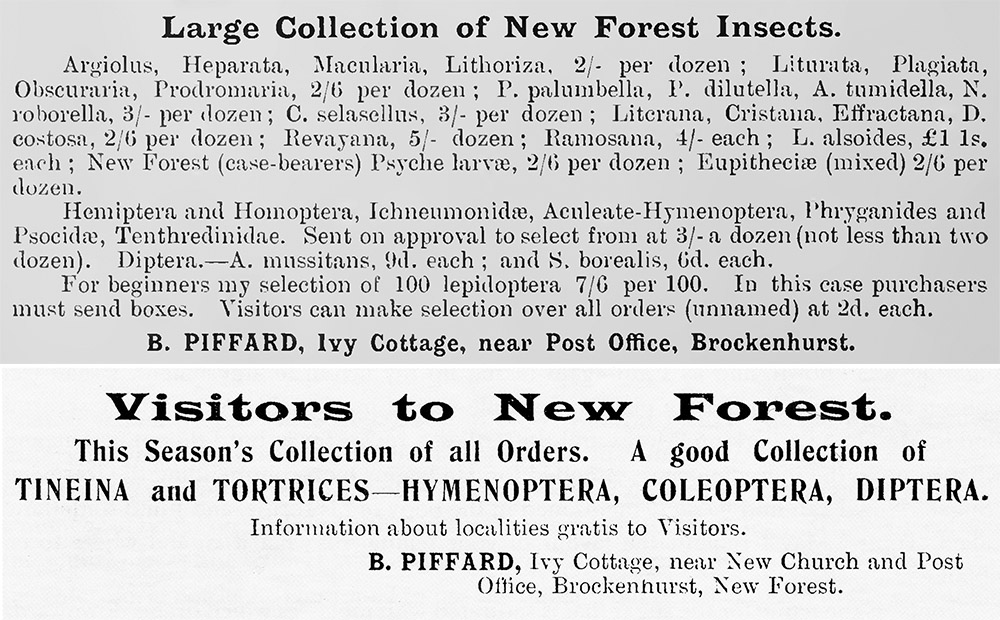
Figure 6.
1902 advertisements from "The Entomologist's Record and Journal of Variation".

Figure 7.
After an 18 year hiatus from professional slide-making, Piffard published this advertisement in "Nature" in November, 1907.
Resources
Baptism record of Bernard Piffard (1833) accessed through ancestry.com
Bracegirdle, Brian (1998) Microscopical Mounts and Mounters, Quekett Microscopical Club, London, pages 74, 75, and 184, and Plate 40-K (suggested that the initials in Piffard's monogram are "P.B.")
Country-Side (1905) Note from Bernard Piffard, Vol. 1, page 130England census and other documents, accessed through ancestry.com
English Patents of Inventions, Specifications (1861) Letters Patent to Bernard Piffard, of 17, Caroline Villas, Kentish Town, in the County of Middlesex, Gentleman, for the Invention of "Improvements in the preparation of non-conducting substances for the deposition thereon of metals by electric action"The Entomologist (1910) Obituary: Albert Piffard, Vol. 43, page 126
The Entomologist (1916) Obituary: Bernard Piffard, Vol. 49, pages 143-144
The Entomologist's Record and Journal of Variation (1902) Advertisements from Bernard Piffard, Vol. 14
Hardwicke's Science-Gossip (1882) Exchange offers from Bernard Piffard, Vol. 18, pages 48, 96, and 284
Hardwicke's Science-Gossip (1882) Local naturalists, Vol. 18, page 73
Hardwicke's Science-Gossip (1883) Advertisements from Bernard Piffard, Vol. 19
Hardwicke's Science-Gossip (1884) Improvements in microscope slides, Vol. 20, page 136
Hardwicke's Science-Gossip (1884) Advertisements from Bernard Piffard, Vol. 20
Hardwicke's Science-Gossip (1885) Exchange offers from Bernard Piffard, Vol. 21, pages 144 and 168
Hardwicke's Science-Gossip (1885) Advertisements from Bernard Piffard, Vol. 21
Hardwicke's Science-Gossip (1886) New slides, Vol. 22, page 79
Hardwicke's Science-Gossip (1886) Advertisements from Bernard Piffard, Vol. 22
Hardwicke's Science-Gossip (1887) Advertisements from Bernard Piffard, Vol. 23
Hardwicke's Science-Gossip (1889) Exchange offers from Bernard Piffard, Vol. 25, pages 48 and 95
Hardwicke's Science-Gossip (1889) Advertisements from Bernard Piffard, Vol. 25
Journal of the Royal Agricultural Society of England (1891) Report on Mr. Piffard's patent silicate manure, page 406 Journal of the Royal Microscopical Society (1884) Piffard's slides, page 655Marriage record of Bernard Piffard and Alice Matilda Watts (1858) Parish records of St. Clement Danes, London, accessed through ancestry.com
Nature (1884) Advertisements from Bernard Piffard
Nature (1885) Advertisements from Bernard Piffard
Nature (1885) Advertisement from Bernard Piffard, November 7 issue, page iii
Patents for Inventions (1884) 202, Piffard, B., Jan. 1, Microscope slides
Piffard, Bernard (1861) On the preparation of non-conducting surfaces for electrotyping, "Having been lately occupied in making some experiments in preparing non-conducting substances for electrodeposition by a chemical process, I send you the result, hoping it may prove useful to some of your readers. For this purpose I prepared a sheet of gutta-percha as follows: 1st, With a solution composed of equal parts of white of egg and a saturated solution of common salt in water, and dried thoroughly. 2nd, With a strong solution of nitrate of silver, and, when dry, I exposed it to light till quite black. 3rd, With a saturated solution of proto-sulphate of iron. This last produces a highly conducting surface of metallic silver. On attaching it immediately (before dry) to the wires of a battery, and immersing it in a solution of sulphate of copper, I obtained a very uniform and rapid deposit without the help of guiding wires", Chemical News, page 323
Piffard, Bernard (1871) The Law from Patmos, Morgan & Scott, London
Piffard, Bernard (1872) Evensong, Simpkin, Marshall, & Co., London
Piffard, Bernard (1881) Unusual abundance of Thecla w-album, The Entomologist's Monthly Magazine, page 68
Piffard, Bernard (1882) Scientific progress in Hertfordshire, Hardwicke's Science-Gossip, Vol. 18, pages 147-148
Piffard, Bernard (1882) Query as to insects, Hardwicke's Science-Gossip, Vol. 18, page 237
Piffard, Bernard (1886) Staining with iodine vapour, Hardwicke's Science-Gossip, Vol. 22, page 29
Piffard, Bernard (1888) Fertilization of Methonica gloriosa, Journal of Botany, British and Foreign, Vol. 21, page 374
Piffard, Bernard (1895) The Duration of Ages
Piffard, Bernard (1896) The Abode of Departed Saints
Piffard, Bernard (1902) Lymington and its insects, The Entomologist's Record and Journal of Variation, Vol. 14, pages 287-289
Probate of the will of Bernard Piffard (1916) "Piffard Bernard of Barley Grove-road Christchurch Hampshire died 28 March 1916 Probate London 5 June to John Wicker baker and Edith Marian Piffard widow. Effects £2337 13s", accessed through ancestry.com
Salmon, Michael, A., Peter J. Edwards (2005) The Aurelian's Fireside Companion, Paphia, Lymington, Hampshire, page 81
Transactions of the Hertfordshire Natural History Society (1884) "The cabinet of microscopic objects at Watford has received the following accessions: … 24 slides of sections of vegetable tissues presented by Mr. Bernard Piffard", page xx
Transactions of the Watford Natural History Society (1875) Inaugural Meeting, 11th February, pages x-xi